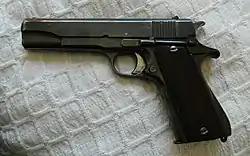Ballester–Molina
The Ballester–Molina is a pistol designed and built by the Argentine company Hispano Argentina Fábrica de Automóviles SA (HAFDASA). From 1938 to 1940 it bore the name Ballester–Rigaud.
| Ballester–Molina | |
|---|---|
 Ballester–Molina pistol | |
| Type | Semi-automatic pistol |
| Place of origin | Argentina |
| Service history | |
| Wars | World War II Ecuadorian–Peruvian War[1] Falklands War[2] |
| Production history | |
| Manufacturer | Hispano Argentina Fábrica de Automóviles SA |
| Produced | 1938–1953 |
| No. built | ~113,000 |
| Specifications | |
| Mass | 1,130 g 1,075 g (unloaded) |
| Length | 212 mm (8,3 in) |
| Barrel length | 127mm (5 in) |
| Cartridge | .45 ACP, .22 LR |
| Caliber | 11.43mm |
| Action | Semi-automatic, recoil operated, blowback (.22 LR variant) |
| Feed system | 7-round detachable single column box magazine |
| Sights | Iron sights |
| References | [3] |
History
The Ballester–Molina was designed to offer the Argentine police and military a cheaper alternative to the Sistema Colt Modelo 1927, itself a licensed copy of the Colt M1911A1, built under the supervision of Colt engineers. Production of the Ballester–Molina began in 1938 and ceased in 1953. The Sistema Colt 1927 was manufactured until 1966, outliving its intended successor by more than two decades.[4]
The company's history dates back to 1929, when two Spaniard entrepreneurs, Arturo Ballester and Eugenio Molina, established a branch of Hispano-Suiza in Buenos Aires. Years later, HAFDASA hired two engineers, Frenchman Rorice Rigaud and Carlos Ballester–Molina, a relative of the founders. Rigaud became the chief designer of the firm, while Ballester–Molina was appointed chief executive officer.[5]
As the Ballester–Molina was designed to serve alongside the Modelo 1927 that was currently in Argentine service, it bears a striking resemblance to the Colt M1911A1. The Ballester–Molina and the M1911 share an identical seven-round magazine, barrel, recoil spring, and barrel bushing. Although many other parts appear identical at first glance, they are not; only the barrel and magazine are interchangeable. The Ballester–Molina is also known as HAFDASA, after the initials of its manufacturer.[6]
Use
The Ballester–Molina was predominantly used by Argentina's security forces. The Argentine Army adopted it as its standard sidearm in 1938. The Ballester–Molina is a short recoil-operated semi-automatic locked breech pistol. The locking system is a near-identical copy of the Model 1911's, with the swinging lock used to unlock the barrel from the slide. The pistol has a two-stage, single action trigger, but unlike that of the 1911 trigger, it pivots rather than slide. The spring housing system is integrated to the pistol frame rather than being a separate part. The hammer is locked by the frame-mounted manual safety, and most notably there is no grip safety. Many examples for sale on the surplus market have seen heavy use but show little internal wear.
Some 10,000 to 15,000 were sold to the United Kingdom during World War II.[4]
In a September 2007 article in the Argentine gun magazine Magnum, about the British-ordered Ballester–Molina pistols, gun writer and collector George E. Arbones' research and collection data seems to indicate the legend British-bought Ballester–Molinas being manufactured using steel salvaged from the German pocket battleship Admiral Graf Spee after she was scuttled in the River Plate in Montevideo harbor, Uruguay. Another specialist, Alejandro Gherovici, dismissed the legend saying the steel was likely supplied by the US under Lend-Lease.[5] Arbones' article also details the use of those pistols by the British 8th Army and the SOE, and how he came to have his own British-marked Ballester–Molinas. Between 10,000 and 15,000 of all Ballester–Molinas were specially manufactured for Britain during World War II. A number of pistols was issued to agents of the SOE, in order to avoid the use of British weapons for undercover operations in occupied Europe and behind enemy lines.In 2002 the publication nº150 of the Magnum Magazine written by Santiago P. Tavella Madariaga provides data on this myth and the manufacture of the British contract Ballester Molina pistol. British contract Ballester–Molinas are identified by serial numbers ranging from 12.000 to 21.000, marked with a "B" prefix (i.e. B16343).
Variants
A version of the Ballester–Molina chambered for .22 Long Rifle was manufactured for training purposes. This version was identical externally to the standard Ballester–Molina, except for slide markings indicating the caliber. However, the .22 caliber version is blowback operated to accommodate the less-powerful rimfire cartridge. This version was produced in much smaller numbers and is much rarer today. The Ballester–Molina pistol also came with an extended barrel and a wooden buttstock.[7]
Users
See also
References
Notes
- Jowett, Philip (28 Jun 2018). Latin American Wars 1900–1941: "Banana Wars," Border Wars & Revolutions. Men-at-Arms 519. Osprey Publishing. p. 47. ISBN 9781472826282.
- Thompson 2011, pp. 65–66
- Hogg, Ian; Gander, Terry (2005). Jane's Guns Recognition Guide. London: HarperCollins Publishers. p. 14. ISBN 0-00-718328-3.
- Thompson 2011, p. 65
- Ballester-Molina
- Fitzsimons, Bernard, general editor. "Ballester Molina", in Illustrated Encyclopedia of 20th Century Weapons and Warfare, Volume 3 (London: Phoebus Publishing, 1977), p.265.
- https://www.flickr.com/photos/jonasdecarvalho/5508405656/in/set-72157626242408185
Bibliography
- Thompson, Leroy (20 May 2011). The Colt 1911 Pistol. Weapon 9. Osprey Publishing. ISBN 9781849084338.
- Hogg, Ian; Gander, Terry Jane's Guns: Recognition Guide London and New York City: HarperCollins Publishers. Fourth Edition, 2005. ISBN 0-00-718328-3.
- Arbones, Jorge E. "Magnum" Buenos Aires, Argentina magazine: "Ballester Molinas Peronistas y Ballester Molinas Inglesas," September 2007 (in Spanish)
External links
| Wikimedia Commons has media related to Ballester-Molina. |